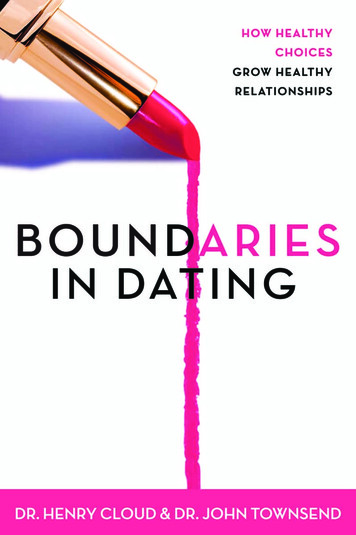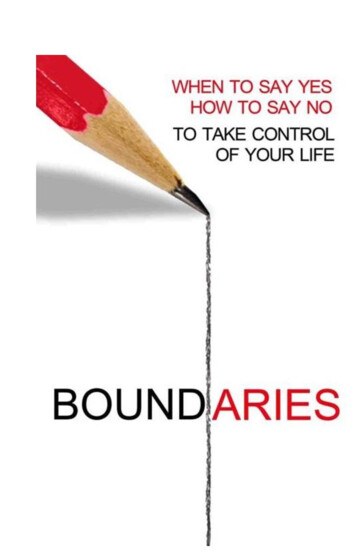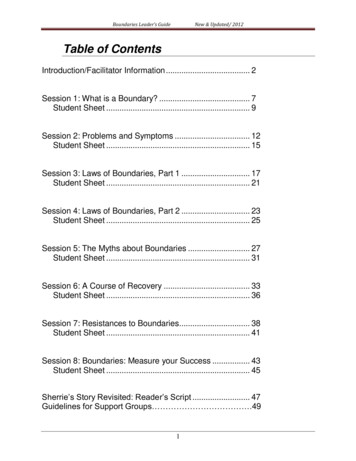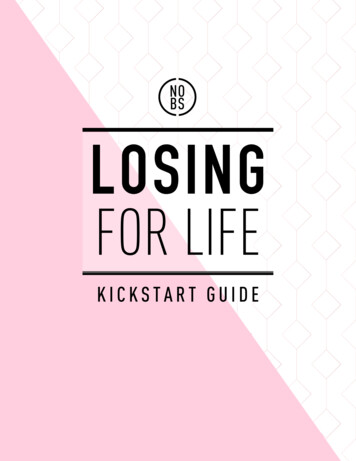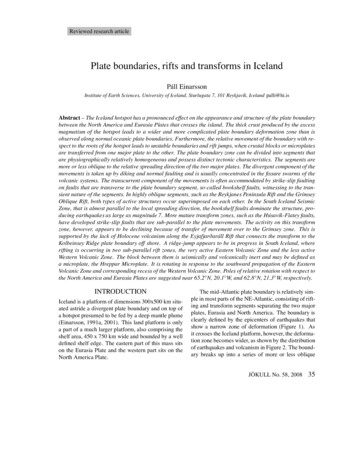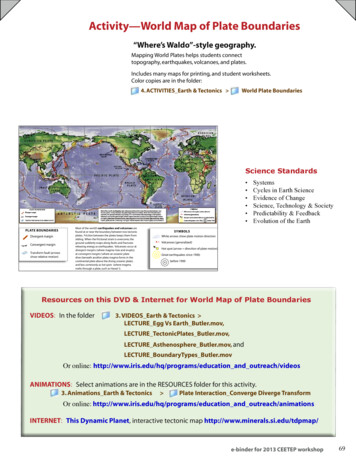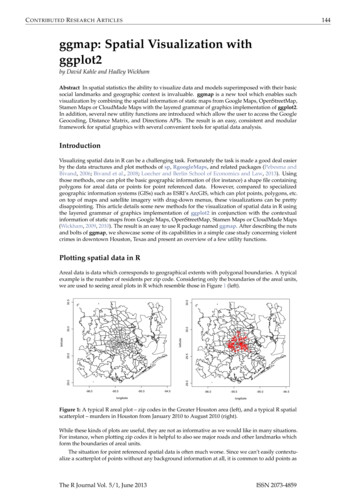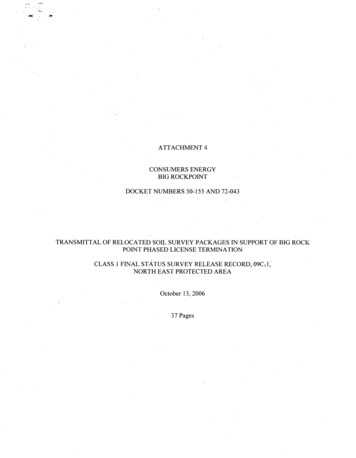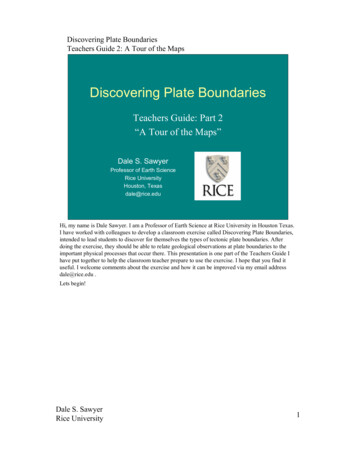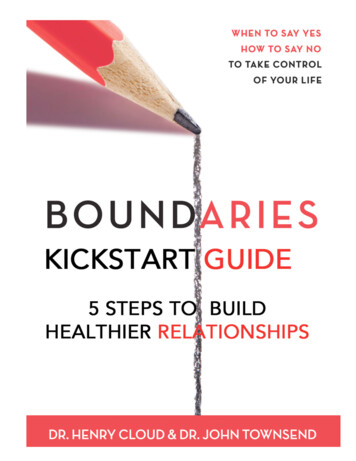
Transcription
1BOUNDARIES KICKSTART GUIDE5 Steps to Build Healthier RelationshipsHow to Use the Kickstart Guide:The Boundaries Kickstart Guide is a free e-book designed to accompany theaward-winning book, Boundaries. You will need a copy of the book to usethis material. Purchase your copy of Boundaries wherever books are sold.This guide provides suggested reading selections from Boundaries and offersinsightful “Questions for Reflection” to walk you through five steps to buildhealthier relationships. After completing the Kickstart Guide, we think you’llagree – boundaries make life better!Step 1 – Understanding BoundariesStep 2 – Setting Boundaries with Your SpouseStep 3 – Setting Boundaries with Your ChildrenStep 4 – Dealing with Boundaries ResistanceStep 5 – Measuring Your Success with BoundariesMaterial in the Boundaries Kickstart Guide is excerpted from the Boundaries Workbook.Copyright 1995 by Henry Cloud and John Townsend.Used by permission of Zondervan Publishers. www.Zondervan.com
2IntroductionOne of the most serious problems facing people today is confusion about boundaries.Many sincere, dedicated, individuals struggle with tremendous confusion about when it isappropriate to set limits. When confronted with their lack of boundaries, they raise goodquestions: Can I set limits and still be a loving person?What are legitimate boundaries?What if someone is upset or hurt by my boundaries?How do I answer someone who wants my time, love, energy, or money?Why do I feel guilty or afraid when I consider setting boundaries?How do boundaries relate to submission?Aren’t boundaries selfish?Why is it difficult for me to hear no from other people?Why do I tend to want to control other people when I don’t get what I want?Just as homeowners set physical property lines around their land, we need to set mental,physical, emotional, and spiritual boundaries for our lives to help us distinguish what is ourresponsibility and what is not. The inability to set appropriate boundaries at appropriatetimes with the appropriate people can be very destructive.Misinformation about what the Bible says about boundaries can also be destructive. Tocounter such wrong thinking, this Kickstart Guide and the accompanying text present abiblical view of boundaries: what they are, what they protect, how they are developed,how they are injured, how to repair them, and how to use them.As you read our book, Boundaries, and work through this Kickstart Guide, you will findanswers to the questions listed above—and more. In fact, our goal is to help you useboundaries appropriately to achieve the relationships and purposes that God intends foryou as you grow in him.Blessings,Dr. Henry CloudDR. John Townsendwww.BoundariesBooks.com
BOUNDARIES KICKSTART GUIDEStep 1 – Understanding Boundaries3Open your copy of Boundaries and read pages 29 – 31, including thesections “What Does a Boundary Look Like?” and “Invisible Property Linesand Responsibility.” Next, return to answer the following questions.Remember the story of Bill? His parents paid his bills, fretted over his circumstances,worried about his future, and exerted much energy to keep him going. Bill didn’t study,plan, or work, yet he had a nice place to live, plenty of money, and all the rights of afamily member who was doing his part. He was irresponsible and happy—and they wereresponsible and miserable.You could compare Bill to a man who never waters his lawn. Whenever his neighbors turnon their sprinkler system, the water falls on Bill’s lawn. Their grass is turning brown anddying, but Bill sees his green grass and thinks his yard is doing fine.In this story, it was suggested to Bill’s parents that they define the property lines a littlebetter and fix their “sprinkler system” so that water would fall on their own lawn. Perhapsthen, when Bill didn’t water his lawn and found himself living in dirt, he would recognizethat he had a problem and would do something about it.Questions for Reflection1. Think of a relationship where you might be watering someone else’s yard while yourown grass withers and dies?2. Do you feel that it is cruel to stop watering someone else’s yard? Do you feel guilty orselfish about the thought of telling someone no?3. Do you tend to feel responsible for other people’s feelings, choices, and behaviors? Inwhat areas of your life, or for which people in your life, do you do this?The goal of this first step is to help you define where your boundaries might be missing.Recognize them as an ever-present part of life that can increase your ability to love othersand protect you from burnout.Open your copy of Boundaries and read the sections “Me and Not Me” and“To and For” on pages 31 - 33. Then, answer the following questions.
4The Purpose of BoundariesBoundaries define us. They define what is me and what is not me. A boundary showswhere you end and someone else begins, leading to a sense of ownership. Often, ourfamily or other past relationships may have confused us about how to properly set limitsfor ourselves and with others. Read the following verses from the Bible:Galatians 6:2 – “Carry each other’s burdens, and you will fulfill the law of Christ.”Galatians 6:5 – “Each one should carry their own load.The original Greek words for “burden” and “load” give important insight into these twoverses. Burden means “excess burdens,” boulders that we need help carrying. Loadmeans “cargo” or “the burden of daily toil.” You could liken the idea to a knapsack. Aknapsack is possible to carry, and we are expected to carry our own. We are expected todeal with our own feelings, attitudes, and behaviors, as well as the responsibilities thatGod has given us, even though it takes effort. In addition, we are not to carry the“knapsacks” of others.Questions for Reflection1. When have you acted as if your “boulder” is your daily load and have refused to askfor help from others? Is this situation currently happening to you? Who should youreach out to for assistance?2. When have you allowed yourself to carry someone else’s knapsack when they shouldbe responsible to carry it on their own? Is this situation currently happening to you?Who do you need to let carry their own load?3. We must own our own thoughts. Do you think things through for yourself, or do youtend to accept other people’s ideas and let them do your thinking for you? Name onearea of your life where you would do well to think through some issues for yourself.In order to not stay in pain or become irresponsible, it’s important to determine what“me” is, where your boundary of responsibility lies, and where someone else’s begins.Open your copy of Boundaries and read the sections “Good In, Bad Out”and “God and Boundaries” on pages 33 – 35. Then, return to answer thefollowing questions.Boundaries Let the Good In and Keep the Bad OutBoundaries help us distinguish our property so we can take care of it. We need to keepthings that will nurture us inside our fences and keep things that will harm us outside. Weneed to keep the good in and the bad out, and that’s what boundaries help us do.
5However, boundaries are not meant to be walls. We should not be “walled off” fromothers. Instead, we are meant to be in community with one another. But, in everycommunity the members have their own space and property.Two aspects of limits are important for creating better boundaries. First, setting limits andseparating ourselves protects love because we are taking a stand against things thatdestroy love. Second, setting limits in order to establish an internal structure is animportant component of boundaries and identity, as well as ownership, responsibility, andself-control.The first aspect is setting limits with others. That means setting limits on our exposure topeople who are behaving poorly. We can’t change other people or make them behaveright, but we can gain some distance from them.Questions for Reflection1. As a result of past emotional injury, have you reversed the function of boundaries tolet the bad in and keep the good out? For instance, is there any pain you are holdinginside rather than expressing it and getting it out of your soul?2. Where are you not opening up to the love and support from the outside that wouldbring healing?3. Where in your life today would you do well to limit your exposure to someone who isdestructive or unhealthy? Why would that be a wise move?Step 1 ReviewTaking care of all that lies within our boundaries isn’t easy. Neither is allowing otherpeople to take care of what lies within their boundaries. Setting boundaries andmaintaining them is hard work. But, as you’ll see in the next step, boundary problemsstem from certain myths that can be addressed. Recognizing misconceptions that causeyour boundary problems can help you establish healthy boundaries for yourself.
BOUNDARIES KICKSTART GUIDEStep 2 – Setting Boundaries with Your Spouse6Open your copy of Boundaries and read the section, “Is This Yours, Mine orOurs?” on pages 157 – 162. Then, return to answer the following questions.If there were ever a relationship where boundaries could get confused, it is marriage,where by design husband and wife “become one flesh” (see Ephesians 5:31). Boundariesfoster separateness. Marriage has as one of its goals the giving up of some of ourseparateness and becoming one. What a potential state of confusion! In fact, moremarriages fail because of poor boundaries than any other reason.The Difference Between Love and ResentmentProblems arise when we blame our spouse for our own lack of limits. But, your spouse isnot responsible for your limits; you are. Only you know what you can and want to give,and only you can be responsible for drawing that line. If you do not draw it, you canquickly become resentful.Questions for Reflection1. Often spouses will do more than they really want to and then resent the other for notstopping them from over-giving. Review Bob and Nancy’s story on pages 161 - 162.What situation in your marriage, if any, does it remind you of?2. Where do you need to set some limits on what you will give your spouse?3. Where do you need to take responsibility for your own wants instead of expectingyour spouse to take care of them all for you?Open your copy of Boundaries and read the sections, “The Law of Sowingand Reaping” and “The Law of Responsibility“ on pages 162–163. Next,answer the following questions.The Law of Sowing and ReapingMany times one spouse may be out of control but may not suffer the consequences ofthis behavior. Letting your spouse suffer the consequences—or being allowed to sufferthe consequences for your own behavior—is not manipulation. Instead, someone islimiting how they will allow themselves to be treated and exhibiting self-control. Thenatural consequences are falling on the shoulders of the responsible party.
Questions for Reflection1. Are there any actions where your spouse is not letting you suffer the consequences?72. Are there any actions where you need to let your spouse suffer the consequences?If so, what is keeping you from letting your spouse suffer the consequences for his orher behavior?The Law of ResponsibilityPeople who set limits exhibit self-control and show responsibility for themselves. Settinglimits is an act of love; by binding and limiting the evil, they protect the good. Instead oftaking responsibility for people we love, or rescuing them, we need to show responsibilityto them by confronting evil when we see it. Keep in mind that the most responsiblebehavior possible is usually the most difficult.Questions for Reflection1. Where are you getting angry, pouting, or acting disappointed in hopes of controllingyour spouse? Where are you waiting to be rescued rather than taking responsibility foryourself?2. Are there any areas where you are giving in to your spouse’s anger, pouting, anddisappointments and thereby taking responsibility for what he or she is feeling? Whereare you rescuing your spouse?3. Explain the difference between being responsible “to your spouse” and beingresponsible “for your spouse.”Step 2 ReviewWhen the husband and wife in a marriage set boundaries, the marriage can then growand develop. Setting and receiving firm boundaries with your spouse can lead to a muchgreater intimacy. Take the risk, knowing that the rewards can be very worthwhile.However, you not only need to address boundaries with your spouse; you also need toaddress boundaries with your children. And, that’s covered in the next step.
BOUNDARIES KICKSTART GUIDEStep 3 – Setting Boundaries with Your Children8Open your copy of Boundaries and read “Having a Sense of Control andChoice” on pages 187 – 188. Next, answer the following questions.Of all the areas in which boundaries are crucial, none is more relevant than that of raisingchildren. How we approach boundaries and child rearing will have enormous impact onthe characters of our kids—how they develop values, how well they do in school, whatfriends they pick, whom they marry, and how well they do in a career.Giving Children a Sense of Control and ChoiceChildren need to have a sense of control and choice in their life. They need to seethemselves not as the dependent, helpless pawns of parents, but as willing, initiativetaking agents of their own lives. If children aren’t allowed to make decisions and skin theirknees as a result, they become atrophied in their change-making abilities. Children need asense that their lives are largely theirs to determine, within the province of God’ssovereignty. Being free to make decisions teaches them to appreciate the consequencesof the choices they make.Questions for Reflection1. Recall the story of Sal and his daughter Pamela. What do you like about the way Saldealt with Pamela’s objection to going to the dentist? What didn’t you like?2. Where can you apply Sal’s approach with your children? Be specific in your plans andthen take action.3. What happens when parents make their children’s choices for them and try to preventthem from making painful decisions?Open your copy of Boundaries and read “Delaying Gratification of Goals”on page 189. Next, return to answer the following questions.The Power of Delaying GratificationThe word now was made for young children. It’s where they live. Yet at some point in ourdevelopment we learn the value of later, of delaying one good for a greater good. Welearn to say no to our impulses, wishes, and desires for some gain down the road.Learning how to delay gratification helps our children become self-sufficient adultsinstead of sluggards who are always in crisis. It also helps them learn to have a goal andwork towards it.
Questions for Reflection1. How did you learn—or how are you learning—the value of delaying gratification?92. How can you begin or continue to teach your children the value of delayinggratification?Open your copy of Boundaries and read “Respecting the Limits of Others”on page 190 - 192. Next, return to answer the following questions.Respecting the Limits of OthersFrom an early age, children need to be able to accept the limits of parents, siblings, andfriends. They need to realize that the world doesn’t revolve around them. Accepting limitsteaches us to take responsibility for ourselves. The longer we hate and resist the limits ofothers, the more dependent on them we will be. We will come to expect others to takecare of us, rather than simply taking care of ourselves.If we don’t teach our children to take a no, someone who loves them far less may take onthe job. Most parents would much rather spare their children from such suffering. Theearlier we teach limits, the better.Questions for Reflection1. The list on page 190 identifies various sources of no in life. At which of the eightstages did you learn to accept the boundary of other people’s no? Why is it better tolearn to accept no from the sources early in the list instead of later in the list?2. How did you learn that you can hurt people you love and that your actions matter?What are you doing to teach your children this lesson?Step 3 ReviewWe need to help our children realize that their actions impact other people. When theyare aware of other people’s needs and hurts, they learn to be responsible for what theydo and say. This lesson can keep our children from being self-centered or controlling.Then, they can become loving people.As parents, we have the challenging task and sober responsibility of teaching our childrento have an internal sense of boundaries and to respect the boundaries of others. Thereare no guarantees that our training will be heeded. Yet as we learn about our ownboundary issues, take responsibility for them, and grow up ourselves, we increase ourkids’ chances to learn boundaries for the adult world where they’ll need them every day.
BOUNDARIES KICKSTART GUIDEStep 4 – Dealing with Boundaries Resistance10Open your copy of Boundaries and read pages 245 – 249, including thesections, “Outside Resistance” and “Angry Reactions.” Then, return toanswer the following questions.We have talked about the necessity of boundaries and their wonderful value in our lives.In fact, we have all but said that life without boundaries is no life at all. But establishingand maintaining boundaries takes a lot of work, discipline, and, most of all, desire. But,even with the desire for a better life, we can be reluctant to do the work of boundaries foranother reason: it can be a war. There will be skirmishes and battles. There will bedisputes. There will be losses.For example, remember the story of Julie who had a difficult time with boundaries mostof her life. The child of a domineering father and a mother who controlled her with guilt,Julie had been afraid to set boundaries with some people because of their anger orbecause of the guilt she would feel for “hurting them.”How are you like Julie? Are you afraid of people’s anger? Of hurting people? Both? Julielearned that people were going to fight hard against her limits. Whom do you expect tofight hard against your limits? Outside resistance—people fighting against yourboundaries—comes in a variety of forms. Let’s look at four of them.Angry ReactionsThe most common resistance from the outside is anger. People who get angry at othersfor setting boundaries have a character problem. Self-centered, they think the worldexists for them and their comfort. If you keep your boundaries, those who are angry atyou will have to learn self-control, rather than using their anger to control other people.Questions for Reflection1. Review the 6 steps for coping with someone’s anger on pages 248–249. What will youdo to internalize these steps and make them your own? When will you take action?2. People who get angry may leave their relationship with you if they can no longercontrol you. Are you willing to take that risk with the angry, controlling people in yourlife? Why or why not?God says he will only do things the right way and that he will not participate in evil. Whenpeople choose their own ways over his, he lets them go. Sometimes, we have to do thesame in our relationships.
11Open your copy of Boundaries and read the section “Guilt Messages” onpages 249 – 252. Next, answer the following questions.Guilt MessagesNo weapon in the arsenal of the controlling person is as strong as the guilt message.People with poor boundaries almost always internalize guilt messages leveled at them.Controlling people who use guilt messages are trying to make you change your choices.God says that we are to give and not be self-centered. He doesn’t say that we have togive whatever anyone wants from us. We are in control of our giving. We are free to makechoices, and we are to take responsibility for their impact on us and other people.Questions for Reflection1. What guilt messages are you dealing with today? By whom?2. Review the six steps for coping with guilt messages on pages 251–252. Which stepsgive you new insight into the dynamics of guilt messages? Be specific about whatyou’ve learned. Which steps call for new behavior? What will you do to internalizethese steps and make them your own? When will you take action?Empathize with the distress the guilt sender is feeling, but make it clear that it is theirdistress. Stop reacting. Give empathy. Be a listener, but don’t take the blame. Make surethat the guilt sender hears that you hear the feeling behind the guilt message.Open your copy of Boundaries and read the sections, “Consequences andCountermoves” and “Physical Resistance” on pages 252 – 255. Next, answerthe following questions.Consequences and CountermovesThe consequences of setting boundaries will be countermoves by controlling people, andthose can be harsh.Questions for Reflection1. Who in your life might react like Brian’s father by setting boundaries? What you aregetting for your lack of boundaries and what you stand to lose by setting boundaries?2. Review the remaining five steps for coping with the consequences of your boundarysetting on pages 253–254. Which steps give you helpful insights into the seriousnessof the boundaries you are considering setting? Be specific about what you’ve learned.Which steps call for new behavior? Which steps offer you strength? What will you doto internalize these steps and make them your own? When will you take action?
12Physical ResistanceSome people can’t maintain their boundaries with other people because they will bephysically overpowered or injured. Physical abuse is a serious problem, and the abuserrequires outside help. The problem will not go away, and it could get much worse. Seekhelp immediately.Questions for Reflection1. If you are in relationship with an abusive spouse or boyfriend, what is God’s messageto you today?2. When will you take action?Step 4 ReviewThe Bible is clear about two principles: (1) We always need to forgive, but (2) we don’talways achieve reconciliation. Forgiveness is something that we do in our hearts; werelease someone from a debt that they owe us. We write off the person’s debt, and sheno longer owes us. We no longer condemn her. She is clean. Only one party is needed forforgiveness: me. The person who owes me a debt does not have to ask my forgiveness. Itis a work of grace in my heart.This brings us to the second principle: we do not always achieve reconciliation. Godforgave the world, but the whole world is not reconciled to him. Although he may haveforgiven all people, all people have not owned their sin and appropriated his forgiveness.That would be reconciliation. Forgiveness takes one; reconciliation takes two.We do not open ourselves up to the other party until we have seen that she has trulyowned her part of the problem. True repentance is much more than saying “I’m sorry”; itis changing direction. Do not think that because you have forgiven that you have toreconcile. You can offer reconciliation, but it must be contingent upon the other personowning her behavior and bringing forth trustworthy fruits.
BOUNDARIES KICKSTART GUIDEStep 5 – Measuring Your Success with Boundaries13Open your copy of Boundaries and read the section, “Practice Baby No’s,”on pages 283 – 285. Then, return to answer the following questions.As strange as it may seem, a sign that you’re having success setting new boundaries isoften a sense of self-condemnation or that you’ve transgressed some important rules inyour limit setting. Many people experience intense critical self-judgment when they begintelling the truth about what is and isn’t their responsibility. Why is that? Let’s look at theanswer in terms of practicing how to say no and the feelings of guilt.Practice Baby No’sWhen experiences in the past have taught you not to set limits, confronting someone on arelatively insignificant matter is never a small step—it’s a huge leap forward. But, thathuge leap must be taken only with careful planning.Growth in setting emotional boundaries must be at a rate that takes into account yourpast injuries. So, it is wise to start small and practice saying no in comfortable situations.Questions for Reflection1. Think back to the story of Shareen. Her mother sent guilt messages whenever Shareenset limits, and her father was enraged whenever she dared disagree. Likewise, whatpast injuries make setting limits and saying no difficult for you?2. With whom can you practice saying no? What support group and/or good friend(s) willyou seek out to work on boundaries with? When will you take that step?Here’s an idea to help you navigate this step: Ask your support group or your goodfriends if you could work on boundaries with them. They will show you their true value intheir response to your truth-telling. Either, they’ll warmly cheer you on in being able todisagree with and confront them, or they’ll resist you. Either way, you’ll learn something.A good supportive relationship cherishes the no of all parties involved. The membersknow that true intimacy is only built around the freedom to disagree. Begin practicingyour no with people who will honor it and love you for it.Open your copy of Boundaries and read “Rejoicing in the Guilty Feelings”on pages 285 – 286. Then, answer the following questions.
14Rejoice in the Guilty FeelingsIf your conscience provided no “how could you?” guilt-inducing messages, it might meanyou were remaining enslaved to the internal parent in your mind. That’s why weencourage you to rejoice in the feelings of guilt. You’re moving ahead.Questions for Reflection1. What evidence is there that you have a weak conscience or an overactive and harshinternal judge? Give specific examples of the kind of condemning self-talk that goeson in your mind.2. In what boundary setting will you feel like you are transgressing when you aren’t?What are you going to do with that guilt?Open your copy of Boundaries and read “Practicing Grown-Up No’s” onpages 286 – 287. Then, answer the following questions.Practice Grown-Up No’sStraightening out the extremely complicated, conflicted, frightening relationships in yourlife is a major goal in becoming a boundaried person and a step that requires somegrown-up no’s. Before considering what to do with these people, make sure that yourgoals for this important boundary work are not confused. According to the discussion onpage 286 in Boundaries and the Scriptures given there, what is the ultimate goal ofboundary work?The goal is to have a character structure that has boundaries and that can set limits on selfand with others at the appropriate times. Furthermore, having internal boundaries resultsin having boundaries in the world.Questions for Reflection1. Who is your number one “boundary buster”? Who is the foremost person in your lifewith whom it’s difficult to set limits? List all the names that come to mind.2. Make a list of your significant relationships. Next to each name, note any specifictreasures that are being violated. What boundaries do you need to set to protectthese treasures? Who will support you as you take this critical step?Developing a well-defined, honest, and goal-oriented character structure enables you totake this crucial step. That structure will also enable you to deal with any crisis that yourboundaries may precipitate. Remember that the conflicts and disagreements that appearalready exist. Boundaries simply bring them to the surface.
15Open your copy of Boundaries and read “Rejoicing in the Absence ofGuilty Feelings” on pages 287 – 288. Then, answer the following questions.Rejoice in the Absence of Guilty FeelingsIf you’ve been working through the steps outlined so far, you have had many experienceswith people who understand love, responsibility, and forgiveness. As a result, your heartnow has somewhere else to go for self-evaluation other than a critical conscience. Yourheart can rest instead in the emotional memories of loving, truthful people. There isnothing to fuel guilt feelings.Questions for Reflection1. Are you noticing an easing up of guilty feelings and an increase of empathic sorrow?Point to a specific instance of setting limits that might have caused you greater guiltand more self-recriminations had it happened before you started setting boundaries.2. Identify some of the people that God has placed in your life and some of the situationshe has seen you through which have helped quiet your harsh internal parent.Think for a second about the last time you were asked for something from someone.Perhaps it was for some of your time that you weren’t sure you had to give. Suppose theperson asking is not selfish, manipulative, or controlling. Reasonable people can makereasonable requests sometimes.So, you were asked for something you weren’t sure you had left over to give. You weren’tsure you could do it with a “cheerful heart.” What happened next is what measuringsuccess with boundaries is all about. You probably did one of two things:1. Since you were unsure, you said yes.2. Since you were unsure, you said no.Which response is more mature? In most cases, the second. Why? It is more responsibleto give out of our resources than to promise that which we might not be able to deliver.Step 5 ReviewIndividuals with successful boundaries aren’t frantic, in a hurry, or out of control. Theyhave direction in their lives, a steady moving toward their personal goals. The reward forwise boundaries is the joy of desires fulfilled in life. Consider the Apostle Paul’s commentsat the end of his life:The time has come for my departure. I have fought the good fight, I have finishedthe race, I have kept the faith. (2 Timothy 4:6–7)
16Does life interrupt the process of the person with mature boundaries? Won’t there betrials, complications, and people wanting me on their track and not God’s? Absolutely.There will be all sorts of resistances to our boundaries and goals.However, the person with mature limits understands, makes room, and allows for thosepotential situations. He or she knows that, should it be needed, a no is waiting inside theheart—ready to use. Not for an at
As you read our book, Boundaries, and work through this Kickstart Guide, you will find answers to the questions listed above—and more. In fact, our goal is to help you use boundaries appropriately to achieve the relationships and purposes that God intends for you as you grow in him. Blessings, Dr.
